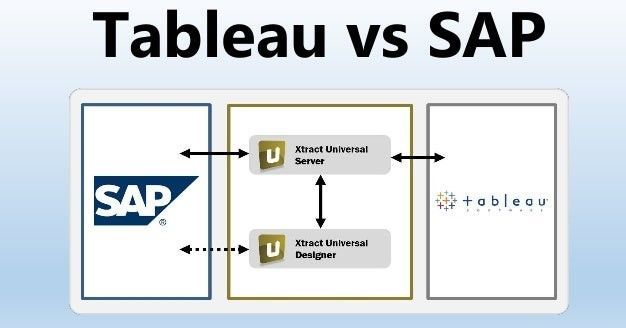
SAP vs Tableau: Choosing the Right Fit

SAP: An Enterprise Powerhouse
When it comes to enterprise software solutions, SAP is undoubtedly a market leader. With a rich history of providing robust and scalable solutions, SAP has established itself as a go-to option for businesses of all sizes. SAP Business Intelligence, commonly known as SAP BI, is an integrated suite of analytics tools that allow organizations to extract, transform, and analyze data from multiple sources.
The platform offers a wide range of functionalities, including reporting, data visualization, and predictive analytics, making it a comprehensive solution for businesses looking to harness the power of their data.
SAP BI Features and Capabilities
SAP BI boasts a plethora of features and capabilities that empower businesses to make data-driven decisions. Let's take a closer look at some of its key offerings:
- Reporting: SAP BI provides a highly customizable reporting interface, allowing users to create insightful reports and dashboards. With the ability to access data from various sources, users can generate real-time reports that provide a holistic view of the business.
- Data Visualization: Visualizing data in a meaningful way is crucial for deriving insights. SAP BI offers a wide range of visualization tools, enabling users to create stunning visual representations of their data. Whether it's charts, graphs, or heatmaps, SAP BI has got it covered.
- Predictive Analytics: Leveraging advanced statistical models, SAP BI allows businesses to forecast future trends and make proactive decisions. By analyzing historical data, the platform can predict future outcomes and help organizations stay one step ahead.
- Mobile Compatibility: In today's fast-paced world, having access to data on the go is essential. SAP BI offers mobile compatibility, allowing users to access reports and dashboards from their smartphones or tablets. This ensures that decision-makers are always equipped with the latest insights, no matter where they are.
Tableau: Unleashing the Power of Visual Analytics
While SAP BI is well-known for its enterprise capabilities, Tableau has gained popularity for its intuitive and user-friendly approach to data visualization and analytics.
Tableau's mission is to help people see and understand their data, and it has succeeded in doing so by providing a powerful yet accessible platform for data analysis. With Tableau, businesses can empower their employees to explore data, uncover patterns, and make data-driven decisions, all without the need for extensive technical expertise.
Tableau Features and Capabilities
Tableau offers a wide array of features and capabilities that make it a favorite among data enthusiasts. Here are some of the key offerings of the platform:
- Drag-and-Drop Interface: Tableau's intuitive interface allows users to easily drag and drop data elements to create visualizations. This eliminates the need for complex coding or scripting, making it accessible to users of all skill levels.
- Interactive Dashboards: Tableau's interactive dashboards enable users to dive deep into their data and explore various dimensions. With just a few clicks, users can drill down, filter, and interact with their data, uncovering valuable insights along the way.
- Smart Insights: Tableau's built-in smart analytics feature helps users find meaningful patterns and trends in their data automatically. By leveraging machine learning algorithms, Tableau can suggest relevant visualizations and insights, saving users valuable time and effort.
- Collaboration: Tableau offers a collaborative environment, allowing users to share their insights and visualizations with colleagues. This fosters a culture of data-driven decision-making and enables teams to work together seamlessly.
SAP vs Tableau: Choosing the Right Fit
When it comes to choosing between SAP and Tableau, there is no one-size-fits-all answer. The choice depends on various factors such as the organization's size, industry, and specific requirements. SAP BI is a comprehensive solution that caters to the needs of large enterprises with complex data landscapes. It offers robust integration capabilities, scalability, and a wide range of functionalities.
On the other hand, Tableau is ideal for organizations looking for a user-friendly and visually appealing platform that emphasizes data exploration and discovery. It is particularly well-suited for small to medium-sized businesses and departments within larger enterprises.